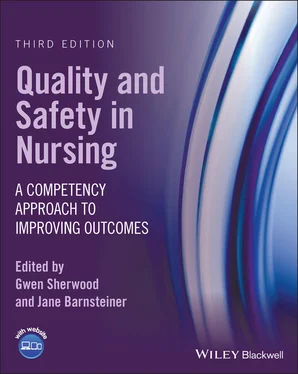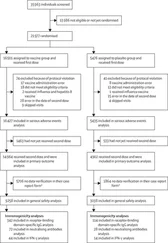Quality and Safety in Nursing
Здесь есть возможность читать онлайн «Quality and Safety in Nursing» — ознакомительный отрывок электронной книги совершенно бесплатно, а после прочтения отрывка купить полную версию. В некоторых случаях можно слушать аудио, скачать через торрент в формате fb2 и присутствует краткое содержание. Жанр: unrecognised, на английском языке. Описание произведения, (предисловие) а так же отзывы посетителей доступны на портале библиотеки ЛибКат.
- Название:Quality and Safety in Nursing
- Автор:
- Жанр:
- Год:неизвестен
- ISBN:нет данных
- Рейтинг книги:5 / 5. Голосов: 1
-
Избранное:Добавить в избранное
- Отзывы:
-
Ваша оценка:
- 100
- 1
- 2
- 3
- 4
- 5
Quality and Safety in Nursing: краткое содержание, описание и аннотация
Предлагаем к чтению аннотацию, описание, краткое содержание или предисловие (зависит от того, что написал сам автор книги «Quality and Safety in Nursing»). Если вы не нашли необходимую информацию о книге — напишите в комментариях, мы постараемся отыскать её.
Quality and Safety in Nursing
Future of Nursing
Quality and Safety in Nursing, Third Edition
Quality and Safety in Nursing — читать онлайн ознакомительный отрывок
Ниже представлен текст книги, разбитый по страницам. Система сохранения места последней прочитанной страницы, позволяет с удобством читать онлайн бесплатно книгу «Quality and Safety in Nursing», без необходимости каждый раз заново искать на чём Вы остановились. Поставьте закладку, и сможете в любой момент перейти на страницу, на которой закончили чтение.
Интервал:
Закладка:
Quality care starts with equitable care. Health is greatly influenced by nonmedical factors that affect communities, such as access to jobs that pay a living wage, safe housing, reliable transportation, walkable neighborhoods, good schools, fresh food, and adequate green spaces. Factors like our race and ethnicity, income level, sexual orientation, disabilities, and the conditions where we live—including in rural and remote areas—predict whether we are more likely to suffer from preventable, costly medical conditions and live shorter lives. Structural racism—defined as a system in which public policies, institutional practices, cultural representations, and other norms work in various, often reinforcing ways to perpetuate racial group inequity—directly prevents many from receiving safe and equitable care. For example, low‐income patients on Medicaid or without insurance in Los Angeles were more likely during the pandemic to receive care in overcrowded safety‐net hospitals, in spite of available room in nearby teaching hospitals with adequate staffing and more lifesaving technology. According to a New York Times article, 86% of COVID‐19 patients who had been intubated at Martin Luther King Jr. Community Hospital in Los Angeles died—a significantly higher number than at nearby teaching hospitals (Fink, 2021). The vast majority were Latino.
The pandemic has underscored the urgency of creating a future that gives everyone a fairer and more just opportunity for health. The National Academy of Medicine’s long‐anticipated report The Future of Nursing 2020–2030: Charting a Path to Achieve Health Equity , released in May 2021, contains a series of recommendations that are designed to unleash the potential for nurses to achieve health equity (NAM, 2021). The following key takeaways from the report are critical to eliminating preventable harm:
Fully support nurses. The report calls on nursing education programs, employers, nursing leaders, licensing boards, and nursing organizations to implement structures, systems, and evidence‐based interventions to promote nurses’ health and well‐being. The report recognizes that structural and cultural changes are needed to prioritize nurse well‐being. When nurses experience poor well‐being, they are more likely to make medical errors (Melnyk et al., 2018).
Permanently remove nurse practice barriers. The report recommends that nurses be allowed to practice to the full extent of their education and training in order to prevent significant and preventable gaps in access to care. For many people, delays in obtaining care lead to worsening of symptoms and disease progression, and to greater costs when they do receive care. Quality care starts with people being able to access care when they need it.
Value nurses’ contributions. The report calls on payment systems to explicitly value nurses’ contributions that improve quality and advance health equity. Examples include case management, care coordination, and team‐based care, which have all been shown to improve quality.
Prepare nurses to tackle health equity. The report calls on nursing education programs to ensure that nurses are prepared to address the social and economic drivers of health and achieve health equity. This includes dismantling structural racism and becoming aware of implicit biases to help nurses provide safer care to everyone.
The pandemic has underscored the importance of prioritizing equity to improve the quality of the care nurses provide locally and globally. As you read this textbook, I urge you to think about how you can use the QSEN competencies to recognize and address inequities in health care.
Susan B. Hassmiller, PhD, RN, FAAN
Robert Wood Johnson Foundation
Senior Advisor for Nursing, and
Director, Future of Nursing: Campaign for Action
References
1 APM Research Lab. (2021) The Color of Coronavirus. March. Retrieved July 1, 2021 from https://www.apmresearchlab.org/covid/deaths‐by‐race.
2 Fink, Sheri. (2021). Dying of covid in a “separate and unequal” hospital. New York Times, February 8. Retrieved July 1, 2021 from https://www.nytimes.com/2021/02/08/us/covid‐los‐angeles.html?smid=url‐share.
3 Hassmiller, S., and Bilazarian, A. (2018) The business, ethics, and quality cases for consumer engagement in nursing. Journal of Nursing Administration, 48(4), 184.
4 Melnyk, B.M., Orsolini, L., Tan, A., et al. (2018) A national study links nurses’ physical and mental health to medical errors and perceived worksite wellness. Journal of Occupational and Environmental Medicine, 60(2), 126–131.
5 National Academies of Sciences, Engineering, and Medicine. (2021) The Future of Nursing 2020–2030: Charting a Path to Achieve Health Equity. Washington, DC: National Academies Press.
6 Ulrich, C.M., Rushton, C.H., and Grady, C. (2020) Nurses confronting the coronavirus: Challenges met and lessons learned to date. Nursing Outlook, 68(6), 838–844.
Preface
2020 was declared the Year of the Nurse and Midwife by the World Health Organization (WHO) and the International Council of Nurses, heightened by the first State of the World’s Nursing report (WHO, 2020). Indeed, nurses were on the front lines of news organizations the world over, but in unexpected ways. We have been writing the third edition of Quality and Safety Education in Nursing as we are in the throes of two cataclysmic events: the COVID‐19 pandemic and the recognition of profound systemic racism in our institutions. Health care organizations across the continuum of care were besieged with critically ill people, a situation compounded by shortages of supplies and equipment to deliver care, often leaving front‐line clinicians forced to deliver care with insufficient staffing and personal protection equipment. As of June 2021, the pandemic has claimed more than 602,917 lives in the United States and more than 3,973,000 worldwide. More than ever, nurses are the heart of health care; stories of overwork, too few resources, and risks are countered with resilience, innovation, compassion, and dedication to keeping patients safe. More than ever, quality and safety are defining aspects of care. Indeed, providing safe quality care begins with adequate resources and system leadership committed to safety culture.
Simultaneously, the disproportionate numbers of deaths of Black and Brown people from COVID‐19 underscore the inequity in health care delivery. Throughout their lives, people of color lack equal access to health care and often receive services of lower quality than the general population. Judith Graham (2020) points out how social and economic disadvantage, reinforced by racism, plays a significant part in unequal health outcomes, all of which threaten quality safe care and the moral fiber of health care.
The need for systemic change in health care and in the education of our future clinicians to ensure safety and quality has become even more apparent. The recently released report Frontline Nurses (WikiWisdom, 2020) poignantly describes the experiences of nurses working at the front lines of the COVID‐19 pandemic. The authors propose solutions to improving health care settings that align with the Quality and Safety Education for Nurses (QSEN) competencies of patient‐centered care, teamwork and collaboration, evidence‐based practice, quality improvement, safety, and informatics. These include:
Developing a comprehensive plan for evidence‐based crisis care that includes input from front‐line nurses.
Creating systems of care that offer care that is safe, transparent, effective, efficient, equitable, and patient centered.
Providing nurses emotional support on the job.
Increasing administrative transparency for patient safety.
Читать дальшеИнтервал:
Закладка:
Похожие книги на «Quality and Safety in Nursing»
Представляем Вашему вниманию похожие книги на «Quality and Safety in Nursing» списком для выбора. Мы отобрали схожую по названию и смыслу литературу в надежде предоставить читателям больше вариантов отыскать новые, интересные, ещё непрочитанные произведения.
Обсуждение, отзывы о книге «Quality and Safety in Nursing» и просто собственные мнения читателей. Оставьте ваши комментарии, напишите, что Вы думаете о произведении, его смысле или главных героях. Укажите что конкретно понравилось, а что нет, и почему Вы так считаете.












